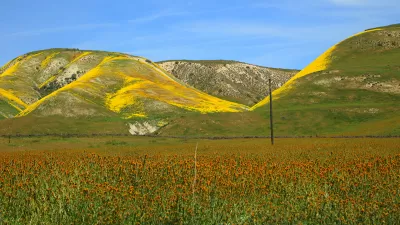According to the most recent PricewaterhouseCoopers "Low Carbon Economy Index," the planet's current carbon intensity will see a 7.2 degree Fahrenheit increase by 2050.
The message of this year's PricewaterhouseCoopers "Low Carbon Economy Index" discussed how, with each year, the world is making it more difficult to avoid climate disaster. This "unmistakable trend" highlights how major economies around the world are failing to meet targets designated by the United Nations' 2009 climate summit to limit global warming to 3.6 degrees Fahrenheit above pre-industrial levels. These targets help to avoid some of the more dire consequences of runaway warming.
As highlighted by Grist writer James West, the PricewaterhouseCoopers report states, "the gap between what we are doing and what we need to do has again grown, for the sixth year running." With the current levels of carbon intensity, we are projected to reach 7.2 degrees Fahrenheit of warming by 2100 — twice the agreed upon rate.
As Brad Plummer explains in a post on Vox, to lower carbon intensity, economies must "burn fewer fossil fuels to generate a dollar's worth of economic activity. Part of the reason for that is our cars, homes, power plants, and factories are all getting more efficient — we can do far more with a given amount of coal, oil, or natural gas than we used to." Although the United States has improved decarbonization by 2.4 percent per year from 2008, in part by the fracking boom replacing coal with natural gas, heroic steps must be taken by large economies throughout the world to ensure the future health of our planet.
FULL STORY: This legendary accounting firm ran the numbers on climate change

Planetizen Federal Action Tracker
A weekly monitor of how Trump’s orders and actions are impacting planners and planning in America.

Maui's Vacation Rental Debate Turns Ugly
Verbal attacks, misinformation campaigns and fistfights plague a high-stakes debate to convert thousands of vacation rentals into long-term housing.

San Francisco Suspends Traffic Calming Amidst Record Deaths
Citing “a challenging fiscal landscape,” the city will cease the program on the heels of 42 traffic deaths, including 24 pedestrians.

Amtrak Rolls Out New Orleans to Alabama “Mardi Gras” Train
The new service will operate morning and evening departures between Mobile and New Orleans.

The Subversive Car-Free Guide to Trump's Great American Road Trip
Car-free ways to access Chicagoland’s best tourist attractions.

San Antonio and Austin are Fusing Into one Massive Megaregion
The region spanning the two central Texas cities is growing fast, posing challenges for local infrastructure and water supplies.
Urban Design for Planners 1: Software Tools
This six-course series explores essential urban design concepts using open source software and equips planners with the tools they need to participate fully in the urban design process.
Planning for Universal Design
Learn the tools for implementing Universal Design in planning regulations.
Heyer Gruel & Associates PA
JM Goldson LLC
Custer County Colorado
City of Camden Redevelopment Agency
City of Astoria
Transportation Research & Education Center (TREC) at Portland State University
Jefferson Parish Government
Camden Redevelopment Agency
City of Claremont





























